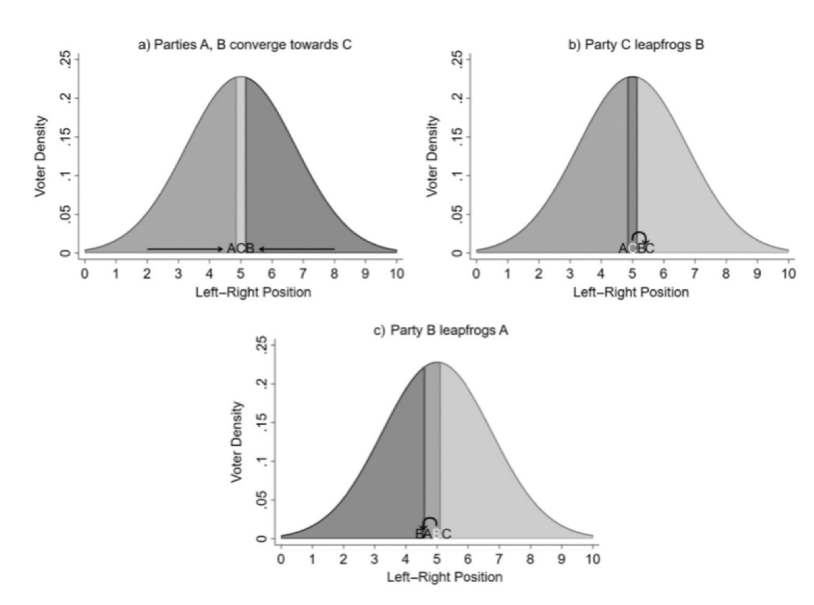L6: Spatial modeling
1/35
There's no tags or description
Looks like no tags are added yet.
Name | Mastery | Learn | Test | Matching | Spaced |
|---|
No study sessions yet.
36 Terms
Arrow and spatial modeling
Arrow shows that there is problem whenever we want to have coherent group choices and the fairness of the method of decision making
What do I mean with fairness?
Do we believe that all preference orders are available to everyone
One way to overcome this problem is to change the universal domain (Condition U) in such a way that a individuals preferences reflect some sort of a consensus
This idea (domain restriction) was invented before
Arrow's theorem by Duncan BlackCan we solve the paradox if we restrict preference choices?
Duncan Black
Economist (1908-1991)
Never came to England
Proud Scotsman
Social choice theorist (another founding father)
Working on a solution for Condorcet paradox
Invented the most famous Universal Domain restriction: Single Peakedness
The idea
all voters are ranking the policy options on a fixed scale
X-axis: alternatives
Y-axis: ordinal rank
We look at the shape of the preference
*Always start with the first preferences on top
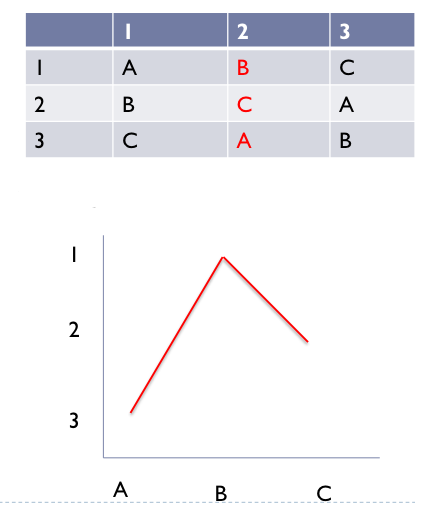
What does it mean to have single-peaked preferences?
A group of agents is said to have single-peaked-preferences if:
Each agent has an ideal choice in the set; and
For each agent, outcomes that are further from his ideal choice are preferred less
Single-peaked preference
All alternatives to be decided can be linearly ordered, left to right
All voters agree on the left to right ordering; they disagree on their choices
Everyone has a favorite point; but the favorite point differs among voters
For each voter, as we move to the left of his/her favorite alternative, his/her utility goes down; as we move to the right of his/her favorite alternative his/her utility goes down
Single peakedness
"We will refer to a curve which is either always upward-sloping, or always downward-sloping, or which is upward-sloping to a particular point and downward-sloping beyond that point (i.e. n shaped), as being a single-peaked curve. On this definition a single-peaked curve is one which changes its direction at most once, from up to down" (Black 1958: 7)
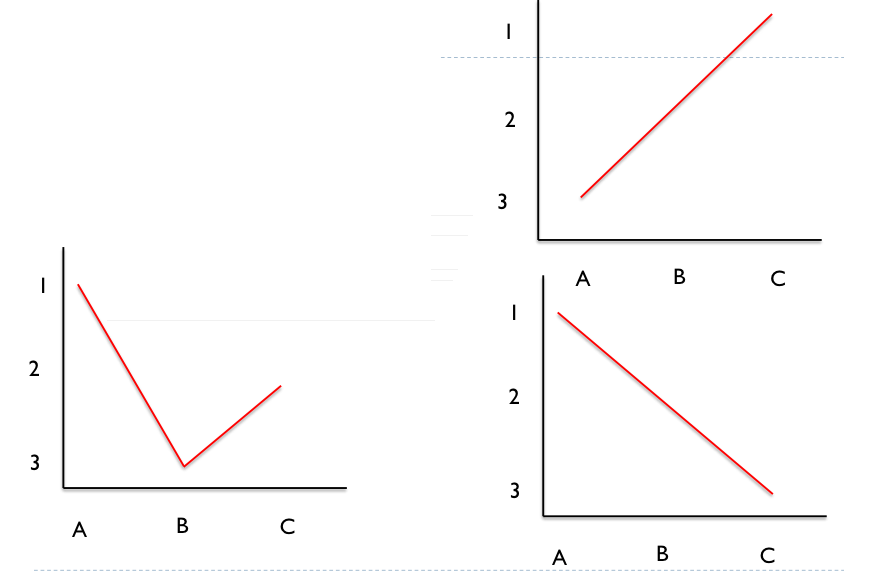
Are these individuals preference order single peaked?
Left corner: no: has two peaks (A & C)
Right top: yes: C is peak
Right bottom: yes: A is peak
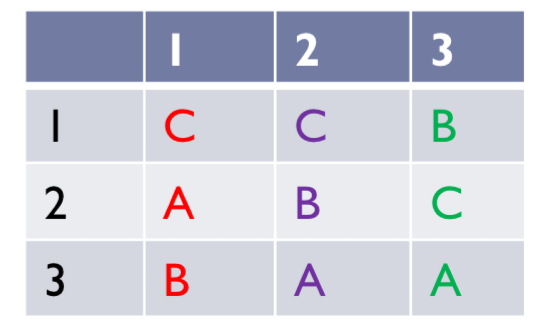
Example
Imagine we are in a group of 3 friends F{I, 2,3}
Each i of F; i E F has to make a preference ordering between 3 alternatives {A, B, C}
They have the following preference orders:
Are they single peaked?
Condorcet winner: C
Red: not single peaked (a c)
A check mark is always two peaked
Green: single peaked (b)
Purple: single peaked (c)
Table does not give rise to paradox
however, maybe this is bc our way of labeling the x-axis?
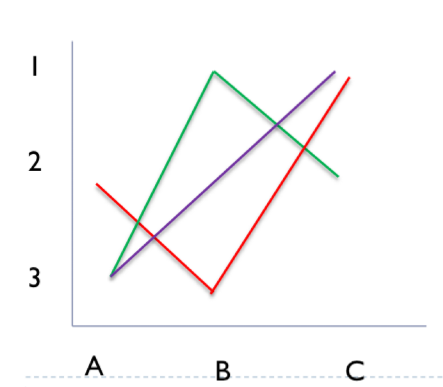
How is Condorcet paradox related to Single-peakedness?
No matter what order the x-axis is in, if one person breaks the SP, someone will always break it if order is switched
Condorcet cycles cannot occur when individual preferences are single-peaked
Single-peakedness as a domain restriction, removes the occurrence of Condorcet cycles
Black’s Theorem
If there is an odd numbers of voters that display single-peaked preferences, then a Condorcet winner exist
In other words: by restricting condition UD, we can prove that the Condorcet paradox will never arise
why should we assume that the voters preferences are single-peaked?
Deliberation
Negotiations → come closer to one another
Single-peakedness to median voter theorem
If preferences are single-peaked, then majority voting on pairwise alternatives yields transitive group decisions
Assumption: number of voters is odd (
Assumption: we can order alternatives on I single dimension
Example of options that we can not order on a single dimension?
The maximum of this ordering is the bliss point of the median voter - the voter whose bliss point has, on the common ordering, as many voters' bliss points to one side as it has to the other
We refer to voters' most preferred outcomes as "ideal points" or " bliss points"
In other words: if all voters have single-peaked curves as preferences, then the median motion will be adopted by the committee
Median example
Preferences
papa bear: hot > warm > cold
Mama bear: cold > warm > hot
Baby bear: warm > hot > cold
Each bear has one peak and one bliss-point
Each bear likes options less and less as we move along the common ordering away from the bliss point, on either side
Lower utility if moving away from bliss
In case every player has one single peak: the median option is the majority winner
What is the majority winner? W
W is in the median for Mama and Papa so they are fine with it
Who is the median voter? Baby
Decides
But check all combinations of the x-axis
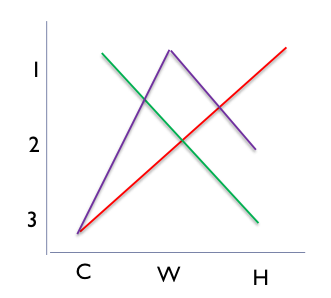
Black’s median voter theorem
when preferences are single-peaked, majority rule preferences are transitive and the feasible alternative which lies highest on the preferences of the median voter is a majority winner (a.k.a. the Condorcet winner)
Median voter: who has the median option as their most preferred
This will be the option chosen
Hotelling’s model and US voting
Parties move towards the center → median
Not seeing extreme parties in two party systems
Republican party did not do this last election
Something not included in model: ignore ideology → does not play a role
So reason why median voter theory does not work in US is bc ideology was so important
Median Voter Theorem
Black (1948) formalized this process
If (I) we can order alternatives along a single dimension and (2) preference orderings are single-peaked along this dimension, then...
There is an identifiable majority preference
This is the preference of the median voter
The ideal point of the median voter has an empty winset
→ The ideal point of the median voter cannot be defeated by a majority
→ The ideal point of the median voter is the majority preference
Winset
The "winset" of alternative A is the set of alternatives that can defeat A by a majority vot
Majority winset (Wy): is a set of alternatives that is preferred by a majority over y
If A's winset is empty, then A cannot be defeated by another alternative
If so we have Condorcet winner
In connection with Black:
The ideal point of the median voter has an empty winset
In connection with Arrow:
It is not always the case that an empty winset exist
Condition U: all preferences (if complete and transitive) may be held (even cyclic ones)
In case of cyclic majority; the winset is not empty!
Median Voter Theorem and Politics
This finding is very important for the proper functioning of democratic systems of government, which rest upon choices made by groups
If preferences are organized along a single dimension, we can identify a group choice that is preferred by a majority
Median Voter Theorem: assumptions
Full participation is assumed i.e., all members of the group have to vote
They participate sincerely i.e., they do not misrepresent their preferences and reveal them honestly
The median voter theory assumes that politician's lack ideological convictions, which could lead them to position themselves away from the median voter
The median voter model assumes perfect information along three dimensions: voter knowledge of the issues; politician knowledge of the issues; and politician knowledge of voter preferences
There is only one single dimension that plays a role...
What type of voting behavior would violate the assumptions of the MVT?
Abstention; many voters do not vote
Some voters vote strategically; voting for a certain candidate not bc they prefer but to avoid another candidate
Voting on issues you are not knowledgeable in
Clientelism
Invalid votes
Single vs multi dimension
The Median Voter Theorem holds for single dimension (for example, left-right dimension)
Black shows that majority intransitivity is impossible with single-peaked preferences
But most policies are not about a single issue
Rather they are packages that deal with multiple issues at the same time
Eg gov spending policy would include welfare spending in addition to military one
Two theorists that deal with multidimensionality:
Plott
McKelvey
Charles Plott
American economist (born 1938)
Plott (1967) generalized Black's Median Voter Theorem to account for multiple dimensions
Plotts Theorem
If members of a group have circular indifference curves (i.e., possess "distance-based" spatial preferences), and if their ideal points are distributed in radially symmetric fashion around the ideal point x*, then the winset of x* is empty (i.e., x* is a Condorcet winner)
If voters possess distance-based spatial preferences, and if their ideal points are distributed in a radially symmetric fashion with x, the ideal point of the voters, and the number of voters is odd, then x cannot be defeated in pairwise majority voting (x has an empty winset)
We can discover multidimensional medians, and therefore a multidimensional group preference, but only under very restrictive conditions
Only if ideal points are distributed symmetrically around the (multidimensional) median
Plott Basic parameters
These round circles are indifferent curves
it is a locus of policy outcomes among which an individual is indifferent (qua utility)
The smaller the circle, the higher the utility
The ideal point is in the middle; that is the most preferred outcome
Closer to ideal point means it is closer to your preference
If an individual's indifference curves are circular, then s/he always prefers points that are closer to those further away (i.e. s/he has
'distance-based' spatial preferences)All points inside the circle, being closer to the ideal, are actually preferred by him or her to the one on the line
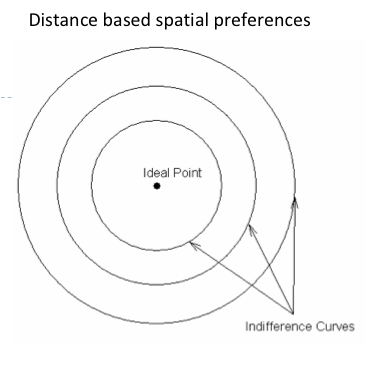
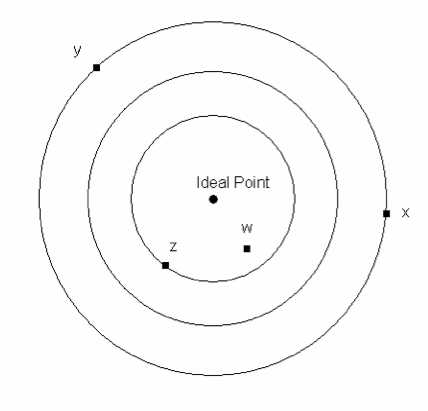
What is the preference order of these indifference curves?
W Pi Z Pi X Ii Y
Plott multiple indifference curves
3 Players; 3 ideal points (pl, p2, and p3)
P1 indifference curve = red
P3 indifference curve = blue
P2 circle is most likely VERY big
Ideal point of player 2 (p2) is the median option
Player 2 (P2) is the median voter
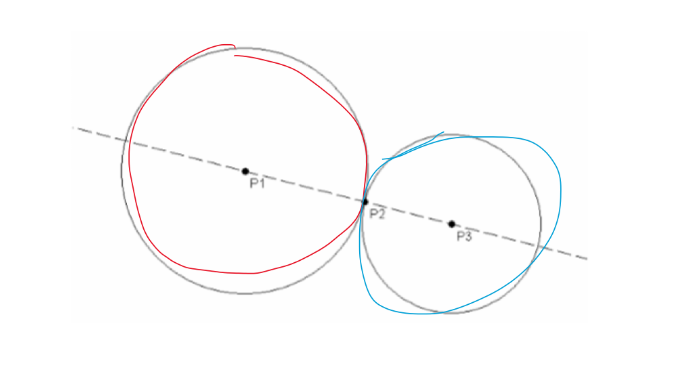
Plott multiple indifference curves: shifting
Imagine we shift the indifference curve and ideal point of p2
Change to the left: p3 does not like it
Change to the right: p1 is does not like it
P2 at its current point is stable → bliss point of p2 is very important
Median voter
Plott: Radically symmetric fashion
the policy space is effectively one dimensional
Radically symmetric fashion explained
The voters on each side of the median have directly opposing interest which cancel them out
A multidimensional space becomes one-dimensional
Answers the question: How is it distributed on the indifference curve
The shape can be folded up into the same shape with middle staying the same → fold a round pierce of paper into triangles
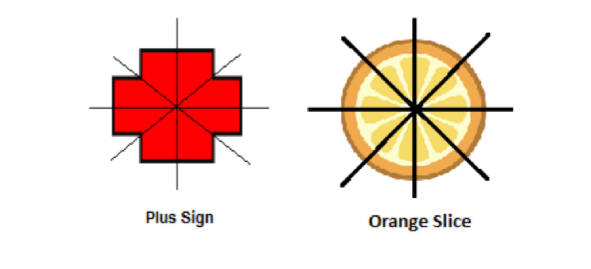
Plott: multiple individuals
Imagine we have two dimensions:
libertarian to authoritarian
left-wing to right-wing
We have 5 voters
Each voter has an ideal point (A, B, C, D, E) and indifference curves (a1, b1, c1, d1, e1)
The bliss point is always in the middle of the indifference curve of that point
Notice that voter C's ideal point is on the line between the ideal points of voters A and B as well as that between D and E
This means that any movement away from C
supported by A will be opposed by B, and vice versaNo three-voter majority prefers any point to C = the majority winset of C is empty
As in the median voter case, all others cancel each other out and the central voter is left to decide
This is a very specific distribution of preferences!!!
No better bliss point that is better for everyone over C

Plott: multiple individuals shift
Now a voter has shifted
Voter D and E are no longer directly opposed when it comes to movements from C
A majority A-D-E would prefer any other point in the shaded winset
There is now always a majority that can win over C
Consequently, radially symmetry no longer exists: there is no winner in a majority vote
Note: Radially symmetric does not require that the points must be equidistant from each other:"they must simply line up"
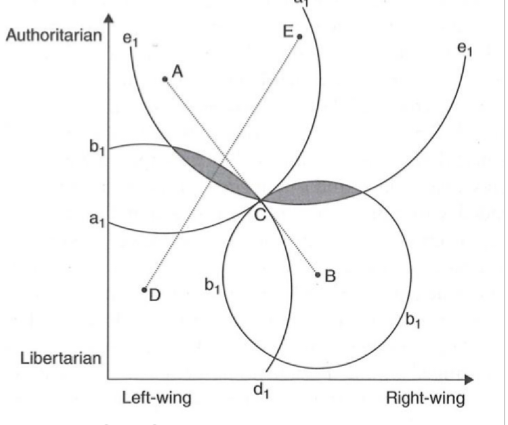
How often is Plotts theorem likely to occur?
Rarely — if ever
Anthony Downs
(1930 - 2021)
American economist
Book: An Economic Theory of Voting (1957)
Uses the Hotelling's model for his spatial model of electoral competition
He is also known for positing the Voting Paradox
Spatial model of electoral competition: set up
there is one ideological (economical) dimension
Democracy
Two parties/candidates
Spatial model of electoral competition: assumptions
Goal for parties: Maximize political support (votes)
Control gov
Goal for voters: Policy
As close as possible to ideal point → want ideal policy to be implemented
Policy is unidimensional on a scale from 0 (left-wing) to 1 (right wing)
Voters vote on party that are closest to their ideological preference
Party who wins majority forms government
No uncertainty in the baseline model
Party cannot deviate from proposed policy once elected
Spatial model of electoral competition
Based on the distribution of voters, parties and/or candidates will position themselves
Bell curve/normal curve
If we fix one candidate's position first, the second candidate will be very close to this one (think about the Hotelling's model)
Candidates should choose the position equal to the ideal point of the median voter (groups will then be of equal size)
In other words, there is a centripetal tendency to the median voter (as was also already suggested by Black)
Spatial model of electoral competition visual
Think about the ted and ed beach video
Converge toward the median → that is where the most voter are
Two party system → parties will converge to the median
The main point of Downs
The starting model used to see how a lot and if voting systems work
